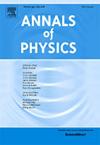A new basis- and integral-free approach to perturbation theory: The Schrödinger dynamics of N trapped ions in the high-intensity regime
IF 3
3区 物理与天体物理
Q2 PHYSICS, MULTIDISCIPLINARY
引用次数: 0
Abstract
A novel, basis- and integral-free perturbative method for the Dyson series describing Schrödinger dynamics in general is introduced. The trapped ions in the high-intensity regime are addressed under this new approach. The approach is based on the Omega Matrix Calculus (OMC) which is rooted in the theory of partitions of natural numbers due to MacMahon. A key ingredient in our formalism comprises a new OMC representation to compute multiple integrals involving the matrix exponential, allowing for a simpler treatment using Omega calculus elimination rules and enhancing previous representations, such as the one by Francisco Neto (2020). This approach not only implies previous perturbative approaches based on divided-differences in Kalev and Hen (2021) and the matrix method in Villegas-Martínez et al. (2022), but also simplifies the derivation process and provides a closed-form expression for the th term in the perturbative expansion solving previously open questions highlighted in prior works, including Villegas-Martínez et al. aforementioned work. Additionally, it reveals that the th term in perturbation theory is governed by a generalized exponential function based on divided differences, which simplifies to the ordinary exponential for . In specific cases, where , , and the interaction term is time-independent, the results are consistent with those obtained by Villegas-Martínez et al.
求助全文
约1分钟内获得全文
求助全文
来源期刊

Annals of Physics
物理-物理:综合
CiteScore
5.30
自引率
3.30%
发文量
211
审稿时长
47 days
期刊介绍:
Annals of Physics presents original work in all areas of basic theoretic physics research. Ideas are developed and fully explored, and thorough treatment is given to first principles and ultimate applications. Annals of Physics emphasizes clarity and intelligibility in the articles it publishes, thus making them as accessible as possible. Readers familiar with recent developments in the field are provided with sufficient detail and background to follow the arguments and understand their significance.
The Editors of the journal cover all fields of theoretical physics. Articles published in the journal are typically longer than 20 pages.
 求助内容:
求助内容: 应助结果提醒方式:
应助结果提醒方式:


